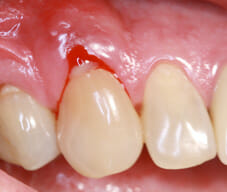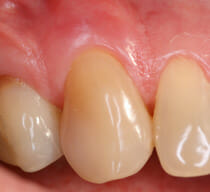Scaling and Root Planing: The Traditional Deep Cleaning Treatment For Early To Moderate Gum Disease
Dr. Alger removes infection-causing bacteria and tartar deposits below a patient’s gum lines through a treatment called scaling and root planing.

At his initial appointment, this patient had bleeding, swelling, pus and a deep gum pocket that harbored bacteria.
What do you mean by scaling and planing?
When plaque and tartar (plaque that has mineralized) are found below the gum line, an extensive cleaning process is required – a process that is more extensive than what a patient typically receives at a routine dental visit.
Sometimes referred to as “deep cleaning,” scaling and root planing is a process during which our team skillfully uses ultrasonic instruments to gently remove tartar deposits and bacterial plaque along and below a patient’s infected gum line. These deposits must be removed to prevent damage to a patient’s teeth and supporting bone.
What can I expect during the procedure?

Scaling and root planing was performed by Dr. Alger to resolve infection and reduce gum pockets without surgery
The terms “scaling and root planing,” can sound somewhat intimidating at first to a patient. Dr. Alger and his staff are uniquely trained to provide this treatment in a comfortable, efficient, and effective manner. During the procedure, you can expect:
- A local anesthetic, such as a Novocain-like medicine, to be applied to ensure your comfort
- Our team will use an ultrasonic scaler to gently remove bacteria and tartar through rapid vibrations
- A mist of water will be applied continuously to rinse away debris
- Water containing tartar and bacteria will be gently suctioned from your mouth, just like a normal cleaning
- We will schedule a follow up appointment for 4-6 weeks out so that Dr. Alger and his hygienist can property evaluate the health of your gums.
Is this the right procedure for me?
If you have been diagnosed with gum disease, this procedure may help you regain your healthy smile. Scaling and root planing is an effective treatment for patients with mild to advanced periodontal disease, characterized by deepened gum pockets or bleeding gums. For patients with mild gum disease, scaling and root planing may be the only treatment required . For patients with more advanced gum disease, it is often an important first step towards regaining a healthy smile.
